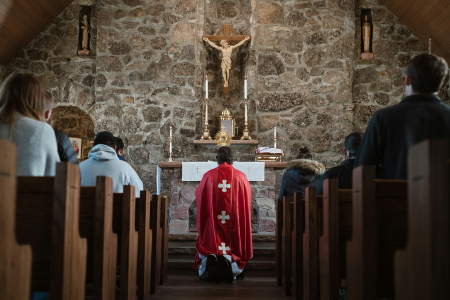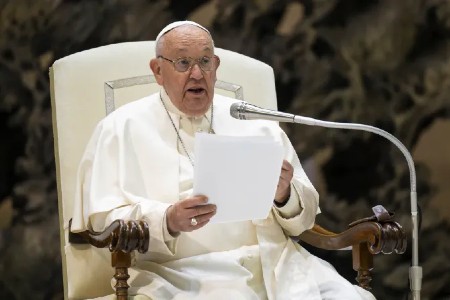We ask you, humbly: don't scroll away.
Hi readers, it seems you use Catholic Online a lot; that's great! It's a little awkward to ask, but we need your help. If you have already donated, we sincerely thank you. We're not salespeople, but we depend on donations averaging $14.76 and fewer than 1% of readers give. If you donate just $5.00, the price of your coffee, Catholic Online School could keep thriving. Thank you.Help Now >
Godfrey of Bouillon
FREE Catholic Classes
Duke of Lower Lorraine and first King of Jerusalem, son of Eustache II, Count of Boulogne, and of Ida, daughter of Godfrey the Bearded, Duke of Lower Lorraine ; b. probably at Boulogne-sur-Mer, 1060; d. at Jerusalem, 18 July, 1100 (according to a thirteenth-century chronicler, he was born at Baisy, in Brabant; see Haigneré, Mémoires lus à la Sorbonne, Paris, 1868, 213). The history of his early years has been distorted by legend, according to which he slew with his own hand the anti-king Rodolphe at the battle of Moelsen (1080), and was first to enter Rome after it had been besieged by Henry IV (1084). What appears certain is that he was chosen to succeed his uncle Godfrey the Hunchback, Duke of Lower Lorraine, who was assassinated in 1076. But Henry IV took Lorraine, leaving to Godfrey only the marquessate of Antwerp. As a vassal of the German Empire Godfrey took sides with the army of Henry IV in the War of the Investitures and followed the emperor on his expedition to Italy against Gregory VII (1080-1084). In the interval he was compelled to return in order to defend his possessions which had been attacked by the Count of Namur, and about 1089 Henry IV restored to him the legacy of Godfrey the Hunchback by creating him Duke of Lower Lorraine. The new duke's authority was extremely weak when opposed to the feudal power which had developed in the vicinity. At this time the whole north of France was aroused by the letter of Urban II, who besought the nobility of Flanders to go on the Crusade. Godfrey was among the first to take the cross, together with his two brothers, Eustache and Baldwin (1096). To procure resources he sold or pledged many of his estates. Many nobles at once arrayed themselves under his banner, and about 15 August, 1096, he departed at the head of 10,000 knights and 30,000 foot soldiers. His army was composed of Walloons and Flemings. "Born at the frontier of the two nations and himself speaking both languages", he served as the link between them, and by his authority appeased the quarrels provoked by their national self-esteem ( Otto of Freising en, Mon. Germ. Hist.: Script., XX, 250).
The crusaders reached the valley of the Danube and in September, 1096, arrived at Tollenburch (Tulin, west of Vienna ), on the frontier of Hungary, where they learned of the disaster that had befallen the followers of Peter the Hermit. Before entering Hungary Godfrey negotiated with King Coloman for a free passage through his dominions. He himself met the king, who welcomed him warmly, but took Godfrey's brother Baldwin as a hostage, together with his wife. During the march through Hungary (October, 1096) the strictest disciplines prevailed among the crusaders, to whom the inhabitants furnished provisions in abundance. After crossing the Save, the army entered the territory of the Byzantine Empire. At Belgrade Godfrey received a letter from the Emperor Alexius I (Comnenus), promising him assistance if the crusaders would refrain from violence. At Nish and at Sterniz (Sofia), they found abundant provisions and presents from the emperor. After a halt of eight days at Philippopolis (26 Nov.-3 Dec.) the army approached Adrianople (8 December) and marched towards the Hellespont. Here occurred the first conflict between the crusaders and the imperial government. According to Albert of Aix , Godfrey, learning that the emperor held in captivity Hugues, a prince of France, demanded the latter's freedom, and on the emperor's refusal pillaged the neighborhood of Salabria (Selymbria). As a matter of fact, the French prince was not a prisoner, but Godfrey and his army arrived before Constantinople (23 Dec., 1096) in a hostile mood, and closely watched by the imperial troops. Warned against the emperor, Godfrey kept away from the imperial palace.
However, during the Christmas festivities, he consented to cross the Golden Horn, and went into camp at Pera (29 Dec.). The chief desire of Alexius was to prevent the junction of Godfrey's army with that of Bohemond, leader of the Normans of Italy ; Alexius had hoped to induce Godfrey to swear fealty to him and then to remove his army to Asia. Throughout the winter Godfrey resisted the imperial demands. At last, 2 April, 1097 (the date given by Anna Comnena is preferable to 13 January given by Albert of Aix ; see Chalandon, "Alexis Comnène", 179), on the approach of Bohemond, the emperor decided to act, and cut off the supplies of the crusaders. Several combats ensued, and, despite the contrary assertion of Albert of Aix, Godfrey must have been defeated. Anna Comnena states that he then consented to do homage to the emperor, promising to restore him any former imperial possessions which he might wrest from the infidels. Some days later the Lorraine army was conveyed to Pelekan on the Gulf of Nicomedia, and at the end of April all the leaders of the crusade were reunited. Godfrey appears to have acted as peacemaker, and he induced Raymond IV, of St-Gilles, Count of Toulouse, to swear fealty to the emperor. Far from directing the crusade, he appears to have taken an obscure part in the siege of Nicæa and the battle of Dorylæum (1 July, 1097).
During the crossing of Asia Minor he was seriously wounded while hunting. At the siege of Antioch he consented to obey the orders of Bohemond, and after the capture of the city he had to give up the castle which his followers had taken (July, 1098). On the way to Jerusalem. while others quarrelled, Godfrey marched towards Edessa, where his brother, Baldwin, had just established himself. He returned from this expedition in October, 1098, and before entering Antioch, with only twelve knights, put to flight one hundred and fifty Turks. According to the tradition repeated by Guibert de Nogent (Gesta, VII, 11), he had, with a stroke of the sword, hewn a Turkish horseman through the middle so that his body fell in two equal halves. Having returned to Antioch, he took part, together with Robert Courte-Heuse, Duke of Normandy, in the council of arbitration assembled to reconcile Bohemond and Raymond of St-Gilles. After 23 November, 1098, a number of the crusaders left Antioch with Raymond, but Godfrey of Bouillon and Robert, Count of Flanders, began to march on Jerusalem only at the end of February, 1099. After besieging Gibel they rejoined the main army before Arka (12 March), were at Tripoli (13 May), Beirut (19 May), Cæsarea (30 May), and reached Jerusalem on 7 June.
Godfrey and his army took an active part in the siege of the Holy City. His camp was pitched to the westward. On 15 July, 1099, about nine in the morning, Godfrey and his brother Eustache placed a movable tower against the walls and were the first to enter the city. During the ensuing massacre of Mussulmans, Godfrey, thinking only of his vow, stripped himself of his arms, and, barefooted and in his under-garments, made the rounds of the ramparts, and then went to pray at the Holy Sepulchre. The crusaders were soon intent on providing a new king for the conquest. Several bishops offered the crown to Raymond of St-Gilles, who refused, declaring "that the title of king seemed to him out of place in that city" (Raimond de Aguilers, Histor. Occid. des Crois., III, 301). Robert Courte-Heuse being urged declined in like manner. All refused to accept the burden which the new royalty must prove. Finally, Godfrey, being unanimously elected, accepted "for the love of Christ" (22 July). According to the chronicles of those times, he refused to wear the crown "through respect for Him who had been crowned in that place with the Crown of Thorns ". Indeed, he seems never to have borne the title of king (which only appears under his successor), and to have been content with that of Duke and Advocate of the Holy Sepulchre .
 Hi readers, it seems you use Catholic Online a lot; that's great! It's a little awkward to ask, but we need your help. If you have already donated, we sincerely thank you. We're not salespeople, but we depend on donations averaging $14.76 and fewer than 1% of readers give. If you donate just $5.00, the price of your coffee, Catholic Online School could keep thriving. Thank you. Help Now >
Hi readers, it seems you use Catholic Online a lot; that's great! It's a little awkward to ask, but we need your help. If you have already donated, we sincerely thank you. We're not salespeople, but we depend on donations averaging $14.76 and fewer than 1% of readers give. If you donate just $5.00, the price of your coffee, Catholic Online School could keep thriving. Thank you. Help Now >
It may be that he acted in this manner through respect for the clergy, who regarded the new conquest as the property of all Christendom, and some of whom were averse to the election of a king (Raimond de Aguilers, Hist. Occid. Crois., III, 295). Godfrey seems to have always considered himself the protector of the Church. Not only did he make so many donations that William of Tyre despairs of enumerating them, not only did he cede a fourth of Jaffa (Joppa), the city of Jerusalem, and the tower of David to the patriarch Daimbert, but he consented, as did Bohemond, to receive investiture from the patriarch ( William of Tyre, Historia, IX, XV). Godfrey displayed great energy in meeting the many difficulties which threatened the new State, but he was destined to succumb to sickness. On 12 August, 1099, having rallied the crusading forces, he gained a victory at Ascalon, thus preserving Palestine from Egyptian invasion.
Assisted by the Pisans, he rebuilt the city of Jaffa, which became a port of arrival for crusaders. He signed a treaty of alliance with the Venetian fleet, agreeing to besiege Acre, but was attacked by the plague at Cæsarea, 10 June. After a short stay at the hospital which he had founded at Jaffa, he returned to Jerusalem, where he died on 18 July, having named his brother Baldwin as his successor. He was buried in the church of the Holy Sepulchre.
The tomb of Godfrey was destroyed in 1808, but at that time a large sword, said to have been his, was still shown. Legend soon laid claim to him; in the contemporary accounts of the First Crusade (Gesta Francorum, Raimond de Aguilers, Foucher de Chartres, Anna Comnena, etc.), he is portrayed as the perfect type of a Christian knight. Tall of stature, with pleasing countenance, and with so courteous a manner "that he seemed more a monk than a knight " (Robert the Monk, Hist. Occid. Crois., III, 731), in the hour of danger he showed admirable courage. As a zealous Christian, he was among the first to take the cross, accomplished his vow without the slightest deviation, and at great personal cost accepted the defence of the new conquest. Such is Godfrey as he appears in actual history. In the chronicle of Albert of Aix (d. 1120, edit. Hist. Occid. Crois., IV), the author already exhibits a tendency to put the figure of Godfrey in the foreground and to attribute to him, to a certain extent, the direction of the crusade. Albert of Aix and Guibert de Nogent attribute to Godfrey exploits of an epic character (Guibert de Nogent, Gesta, VII, 11). When, in the thirteenth century, Jean d'Ibelin and Philip of Novara edited the "Assises" of Jerusalem, they referred to Godfrey as a law-making king, and attributed to him a code, the "Letters of the Holy Sepulchre ", which never existed. Indeed, at that time, and perhaps as early as the twelfth century, Godfrey of Bouillon had become, like Roland and Arthur, a hero of the chansons de geste . The trouvères provided him with a mythical origin, making him a descendant of the legendary "King of the Swan", whose feats he is made to repeat, and, after relating the events of his childhood, continued his adventures to the taking of Jerusalem. Under Philip Augustus, Graindor of Douai reconstructed the works of a certain Richard the Pilgrim, and composed a complete history of this crusade : (1) "Elioxe", ed. Todd (Baltimore, 1889); (2) "Beatrix", ed. Hippeau (Paris, 1868); (3) "Antioche", ed. P. Paris (Paris, 1848); (4) "Jérusalem", ed. Hippeau (Paris, 1868); see L. Gautier, "Bibliographie des chansons de gestes" (Paris, 1897). In the fourteenth century, all these poems were collected under the title of "Roman du chevalier au Cygne" (ed. de Reiffenberg, Brussels, 1846-59).
Join the Movement
When you sign up below, you don't just join an email list - you're joining an entire movement for Free world class Catholic education.
-

-
Mysteries of the Rosary
-
St. Faustina Kowalska
-
Litany of the Blessed Virgin Mary
-
Saint of the Day for Wednesday, Oct 4th, 2023
-
Popular Saints
-
St. Francis of Assisi
-
Bible
-
Female / Women Saints
-
7 Morning Prayers you need to get your day started with God
-
Litany of the Blessed Virgin Mary
U.S. Catholic Parishes Experience Resurgence of Traditional Practices
-

Pope Francis Urges Faith and Prayers for Peace
-

Florida Welcomes Volunteer Chaplains to Public Schools
-
10 Fascinating Details About St. Joseph the Worker: Celebrating His Feast Day - May 1
-
St. Joseph the Worker: Model for Men, Young and Old
Daily Catholic
 Daily Readings for Thursday, May 02, 2024
Daily Readings for Thursday, May 02, 2024 St. Athanasius: Saint of the Day for Thursday, May 02, 2024
St. Athanasius: Saint of the Day for Thursday, May 02, 2024 The Our Father: Prayer of the Day for Thursday, May 02, 2024
The Our Father: Prayer of the Day for Thursday, May 02, 2024- Daily Readings for Wednesday, May 01, 2024
- St. Marculf: Saint of the Day for Wednesday, May 01, 2024
- To Saint Peregrine: Prayer of the Day for Wednesday, May 01, 2024
We ask you, humbly: don't scroll away.
Hi readers, it seems you use Catholic Online a lot; that's great! It's a little awkward to ask, but we need your help. If you have already donated, we sincerely thank you. We're not salespeople, but we depend on donations averaging $14.76 and fewer than 1% of readers give. If you donate just $5.00, the price of your coffee, Catholic Online School could keep thriving. Thank you.Help Now >
![]()
Copyright 2024 Catholic Online. All materials contained on this site, whether written, audible or visual are the exclusive property of Catholic Online and are protected under U.S. and International copyright laws, © Copyright 2024 Catholic Online. Any unauthorized use, without prior written consent of Catholic Online is strictly forbidden and prohibited.
Catholic Online is a Project of Your Catholic Voice Foundation, a Not-for-Profit Corporation. Your Catholic Voice Foundation has been granted a recognition of tax exemption under Section 501(c)(3) of the Internal Revenue Code. Federal Tax Identification Number: 81-0596847. Your gift is tax-deductible as allowed by law.











 Daily Readings for Thursday, May 02, 2024
Daily Readings for Thursday, May 02, 2024 St. Athanasius: Saint of the Day for Thursday, May 02, 2024
St. Athanasius: Saint of the Day for Thursday, May 02, 2024 The Our Father: Prayer of the Day for Thursday, May 02, 2024
The Our Father: Prayer of the Day for Thursday, May 02, 2024
